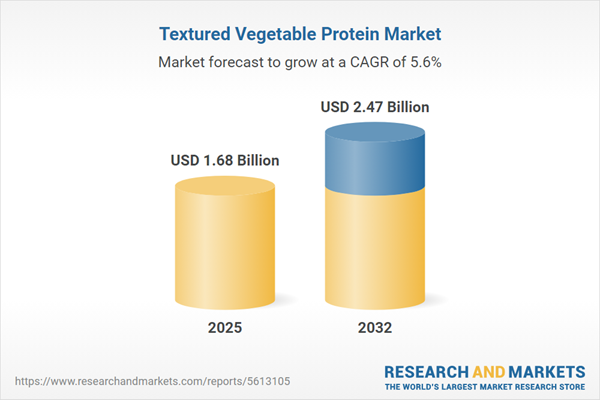Speak directly to the analyst to clarify any post sales queries you may have.
Textured vegetable protein is reshaping global food production, enabling formulators to deliver plant-based products that meet evolving sustainability and performance demands. As industry leaders seek reliable insights to support their next strategic move, this report provides the visibility senior decision-makers require across supply chains, technologies, and regional opportunities.
Market Snapshot: Growth in the Textured Vegetable Protein Market
The textured vegetable protein market grew from USD 1.59 billion in 2024 to USD 1.68 billion in 2025. It is projected to maintain a CAGR of 5.63%, reaching USD 2.47 billion by 2032. This growth is underpinned by rising consumer demand for plant-forward nutrition and scalable production models, positioning textured vegetable protein as a preferred ingredient for food innovation and sustainable protein solutions.
Scope & Segmentation
- Product Types: Pea protein, soy protein, and wheat protein offer distinct performance profiles for product developers in beverages, snacks, and meat analogues.
- Forms: Chunks, flakes, granules, and nuggets each deliver unique textures—serving applications ranging from ready meals to protein-rich snacks.
- Natures: Conventional options ensure broad availability and competitive pricing, while organic varieties cater to clean-label and eco-conscious buyers.
- Applications: Meat analogues, ready meals, snacks, nutritional products, and pet food reflect the expanding versatility of textured vegetable protein.
- Regions: Coverage includes the Americas, Europe, Middle East and Africa, and Asia-Pacific, with further focus on sub-regions such as North America, Latin America, Western Europe, Middle East, Africa, China, India, Japan, and Southeast Asia.
- Key Companies: Highlights include AGT Food and Ingredients, Archer Daniels Midland Co., Axiom Foods, Cargill, Cosucra Groupe Warcoing SA, Crown Soya Protein Group, and Wilmar International Limited, among others engaged in capacity expansion and product development.
Key Takeaways for Decision-Makers
- Advances in extrusion and texturization technologies now produce fibrous structures replicating animal proteins, central to modern meat analogue and meal applications.
- Market complexity is increasing as consumer demand shifts to products with both sensory appeal and verified sustainability credentials, prompting investment in traceability initiatives and third-party certifications.
- Supply chain strategies are diversifying, including vertical integration and regional production, addressing risks posed by volatile trade policy, material pricing, and climate disruption.
- Partnerships, joint ventures, and targeted mergers are accelerating innovation, portfolio expansion, and entry into fast-growing niche segments, enhancing competitiveness.
- Segmented approaches enable tailored offerings, with pea, soy, and wheat-based proteins each positioned for specific functional and nutritional needs in plant-based formulations.
Tariff Impact: Navigating US Policy Shifts
Forthcoming United States tariffs targeting select plant-based protein imports are anticipated to adjust the competitive landscape by raising costs on imported protein isolates and concentrates. This policy shift is likely to encourage greater sourcing from domestic or alternative origins, although near-term supply bottlenecks may arise. Players are re-evaluating cost structures, seeking local supplier alliances, and updating inventory systems to maintain flexibility in a changing procurement environment.
Methodology & Data Sources
This market study is grounded in a multi-phase approach, combining qualitative and quantitative research to deliver actionable insights on the textured vegetable protein ecosystem. The analysis integrates industry stakeholder interviews, detailed secondary research of industry publications and regulations, and rigorous data triangulation to ensure accuracy and reliability.
Why This Report Matters
- Enables executives to assess investment priorities with confidence, supporting resource allocation in product innovation, supply chain resilience, and capacity expansion.
- Provides highly structured segmentation perspectives, helping identify and capitalize on emerging trends in form, product type, application, and regional market dynamics.
- Equips stakeholders to anticipate regulatory and trade disruptions, facilitating well-informed, risk-mitigated strategic planning in the textured vegetable protein sector.
Conclusion
As textured vegetable protein gains traction across categories, stakeholders who prioritize supply chain agility and innovation will be best positioned to benefit from sustained sector growth. This report supports informed decision-making for leaders navigating the evolving plant-based protein landscape.
Additional Product Information:
- Purchase of this report includes 1 year online access with quarterly updates.
- This report can be updated on request. Please contact our Customer Experience team using the Ask a Question widget on our website.
Table of Contents
3. Executive Summary
4. Market Overview
7. Cumulative Impact of Artificial Intelligence 2025
Companies Mentioned
The companies profiled in this Textured Vegetable Protein market report include:- AGT Food and Ingredients
- Archer Daniels Midland Co.
- Axiom Foods, Inc.
- Beneo GmbH
- Cargill, Incorporated
- Cosucra Groupe Warcoing SA
- Crown Soya Protein Group Company
- Devansoy Inc.
- dsm-firmenich Nutritional Products AG
- Emsland Group
- Foodchem International Corporation
- GEMEF INDUSTRIES
- Gushen Biological Technology Group Co., Ltd
- DACSA Group
- MGP Ingredients, Inc.
- Puris Proteins, LLC.
- Sonic Biochem Extractions Pvt. Ltd.
- Sotexpro S.A. by Gemef Industries
- Sun Nutrafoods Inc.
- Victoria Group A.D.
- Vippy Industries Ltd.
- Wilmar International Limited
Table Information
| Report Attribute | Details |
|---|---|
| No. of Pages | 186 |
| Published | November 2025 |
| Forecast Period | 2025 - 2032 |
| Estimated Market Value ( USD | $ 1.68 Billion |
| Forecasted Market Value ( USD | $ 2.47 Billion |
| Compound Annual Growth Rate | 5.6% |
| Regions Covered | Global |
| No. of Companies Mentioned | 23 |








![Textured Vegetable Protein Market Size and Forecast, Global and Regional Share, Trend, and Growth Opportunity Analysis Report Coverage: By Source, Product Type, Category, Application [Food and Beverages and Animal Nutrition], and Geography - Product Image](http://www.researchandmarkets.com/product_images/12739/12739738_60px_jpg/textured_vegetable_protein_market.jpg)
